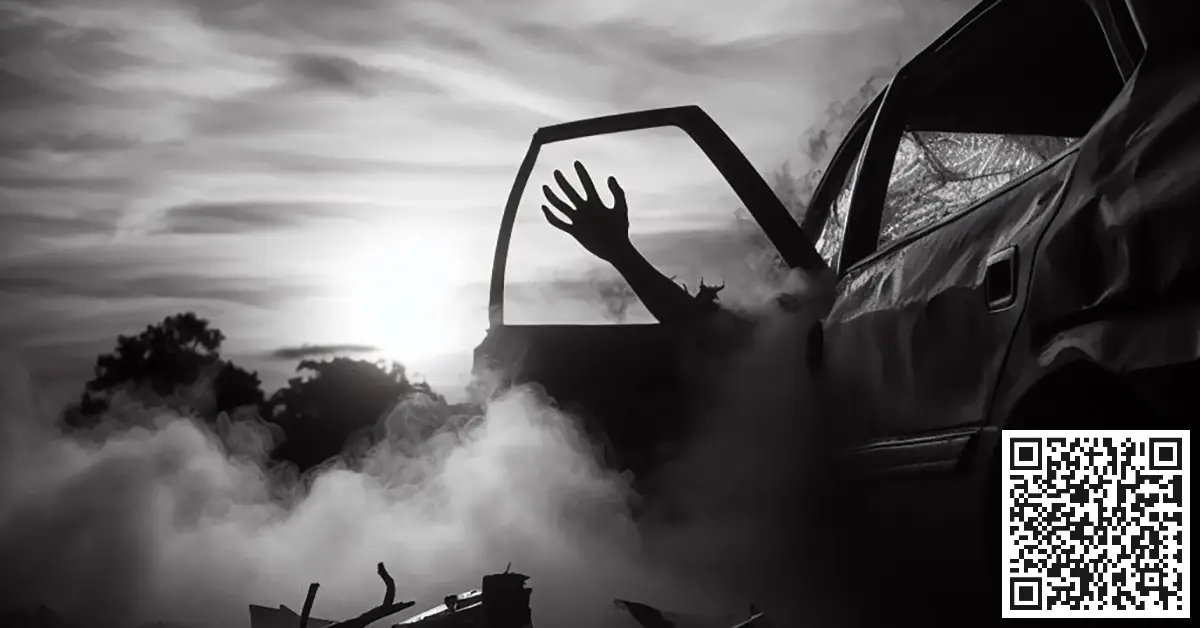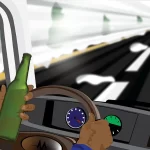‘Victim of wrong rescue’ is a poem which highlights the importance of providing proper care to accident victims at crash sites.
Though the poem itself focuses on road accidents, the whole article is about how to rescue disaster, as well as accident victims.
Press play below for a video about a ‘victim of wrong rescue’, and also read the article that follows.
Victim of Wrong Rescue
Bad Samaritans were first at the scene,
scampering with authority and keen,
like workers on urgent business routine
Eyes locked with mine as one took a lean,
picking my wrist and pockets clean,
not bothering to help, or intervene
I lay there obediently, acting unseen
in a red pool that tasted like saline
Finally, calm and serene
for several minutes, probably fifteen
I was warped and immobile, like a figurine
neither alive nor dead, just in-between;
lower half wrapped in steel, like sardine,
with a heavy band just below my spleen
I saw less and less, like a smoke screen
as again, inverted feet began to convene
I awoke to ramming on metal pleat,
legs tingly like I tarried on toilet seat,
back receiving waves of shock and heat,
but thankful I could wiggle my feet
“Protect the spine”, “leave me the seat”
I tried to caution the busy fleet
as they labored on this daunting feat
but all that came out was inaudible bleat
Tears dropped on a torn receipt,
for while pulling from the unyielding suite,
like novices extracting oyster meat,
I felt a snap where chest and tummy meet,
then nothing, below the dividing sheet;
not numb, just nothing, like concrete
I saw myself alone on the busy street
with haunting memories playing in repeat:
The drinking, sniffing and every taboo,
the car, the racers, the taunt to pursue,
the loss of control as a tire blew,
the trailer headlights out of the blue,
the unheralded stray cow and ewe,
the sickening thud, and deafening “moo”,
the bridge, and giddiness as the car flew,
the shattering glass, and panic anew
Doctors gave their expert view:
my spinal cord was cut in two,
likely from the wreckage pull-through,
without precautions like paramedics do
I’m on wheelchair unable to lace my shoe,
or even tell when bowel movement is due,
but alive, so my helpers, thank you
I’m just a victim of wrong rescue
Background
In some countries paramedics and/or the ‘fire department personnel’ may be at accident scenes within minutes. On the other hand, most countries do not have such effective emergency care response.
It is therefore important for the average citizen to know basic do’s and don’ts of accident scenes.
How to save a life the right way
Whether it is a domestic accident, natural disaster, or road traffic incident, timely and proper response may help you to save a life. Most importantly also, you can try to save it right.
While no two mishap or accident scenes will be exactly the same, the general principles of rescue, are.
NOTE: Time may be of the essence to ensure a successful rescue mission, therefore, follow the following steps concurrently, and quickly.
1. Make sure you are safe, first.
To save a life, you have to be safe, first.
It is normal to become emotional, and tend not to rationalize, when family or friends are in immediate danger; however, you must try not to allow emotions to becloud your judgement.
Quickly check your environment, and the vicinity of the person(s) in need of help:
- Are there dangerous, unstable objects, like falling stones?
- Is there anything that may ignite? for example, a rolled over fuel tanker, or cylinder of gas close to open flame.
- Spilled engine oil in a car garage or mechanic workshop may cause you to fall, while trying to rescue a person on the floor.
- Exposed electric wire on a wet floor may cause electrocution.
- You may not know if a person has a contagious condition, therefore, do not be in a hurry to attempt mouth-to-mouth respiration (rescue breaths).
The right thing to do is be safe first, so as to be able to save or rescue persons in danger.
You should take necessary precautions, accordingly.
2. Warn others, that may come to assist.
If you are the first person at the scene of an emergency, you may need the assistance of others.
Where effective emergency care services are available, place a call (for example, 911 in the United States) to the rescue team.
Before the arrival of assistance, try to secure the environment:
- If it is a vehicle accident scene, and you are driving, park your car at a safe distance from traffic path and put on your blinkers (hazard lights).
- Remember to lock your car, because while you are trying to save a life, some persons may have other plans.
- Get any material, like a shirt or a foot mat, and wave it to catch the attention of other motorists and passers-by.
- Make sure there is no open flame, like a lit cigarette at any vehicle accident scene, even if it is not obvious that fuel is leaking.
3. Division of labor helps to 'save a life' faster.
At an accident or disaster scene, time is usually of the essence, if it involves lives.
Division of labor is an effective way to get many things done quickly.
- One person may be on the phone giving directions to the emergency team.
- Another may be waving down or warning passers-by about the incident.
- Some may be trying to clear rubble, or open a stuck car door.
- Others may help to attend to victims of such incident.
4. Keep the victim(s) safe, while saving the life.
At any accident scene, always remember the following:
- If you have to break a vehicle glass to save a life, break that which is farthest from the vehicle occupant(s).
- In many cases, the vehicle ignition may be on; switch it off.
- Talk to the vehicle occupant(s); ask if they need help:
- Respect their wish, if they refuse.
- If a vehicle occupant is unconscious, that is, does not respond to questions, or gentle tap, you may go ahead with the rescue.
- NOTE: Fear of legal action, for unintentional injury or wrongful death makes people to be hesitant to help accident or disaster victims. The Good Samaritan Law was therefore put in place to encourage people to help accident or disaster victims, especially when they are unconscious.
- In the event of an accident (or any disaster), panic may make the victim to act erratically. Be careful, so that you do not come to harm.
- Do not move the victim UNLESS there is absolutely no option. Some injuries may not be immediately visible; for example, spinal cord injuries. Such injuries may worsen, if you move the victim.
- Where effective emergency care services are available, please wait for their arrival.
- While trying to rescue a person from a mangled vehicle, try to disassemble the wreckage in such a way that it does not involve pulling the person.
- You can gently strap the person to the seat in the position you met him/her.
- In a situation whereby there is no emergency care service, you may have to move the victim (see below).
5. How to deal directly with an accident victim
It is much easier to save a life the right way, if you have some knowledge of first aid or basic life support.
You can join the red cross or red crescent society; what you will learn there goes beyond how to rescue accident victims. See the List of Red Cross and Red Crescent Societies to know which branch is closest to you.
There is an important rescue technique known as CPR (Cardio-Pulmonary Resuscitation); this poem/article sheds some light on it: Do Not Resuscitate (the truth about my condition).
CPR involves chest compressions and rescue breaths; if you do not know how to do it (CPR), just follow these principles.
- First, the ABC principle (Airway, Breathing, Circulation).
- Airway: Is there anything obstructing the airway? Sand, wood, clothes or any other material may be on the face; remove it.
- Breathing: Observe carefully to see if the chest is moving up and down as in breathing; you may also use the back of your hand to feel if there is air coming out of the nostrils.
- Circulation: If you know how to check for a pulse, do so; this is where a knowledge of CPR is particularly important.
- Attend to actively bleeding wounds immediately by doing the following:
- Get a piece of fabric, that can cover the wound very well; you may have to tear a shirt or other clothing material (try not to expose the victims body unnecessarily).
- Apply the fabric, preferably folded to the wound and apply firm pressure.
- You may need to tie the wound: tight enough to stop bleeding, but not too tight to cut off circulation.
- If an object impales the body, do not attempt to remove it, because it may cause uncontrollable bleeding.
- If you must move the victim, for example, where you are not expecting an emergency team, the following tips may help:
- Get anything that you can use as a stretcher to carry the victim; it may be plastic or folded cardboard/ carton box.
- Try to secure the person to this make-shift stretcher, being cautious as much as possible, not to move especially the spine or neck.
- Reassure the victim, because panic only makes things worse.
Conclusion
To rescue an accident or disaster victim the right way, you must first ensure that the environment is safe for you as well as the victim.
Where available, call or get someone to call the emergency care line.
Do not move the victim unless it is absolutely necessary.
Remember the ABC principle and also try to reassure the victim.




